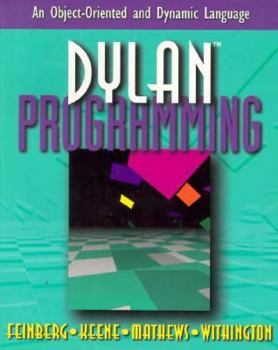Dylan Programming
This book will be useful to anyone learning dynamic, object-oriented programming, whether it be in Dylan, Java, Smalltalk, or Lisp. - Andrew Shalit, author of The Dylan Reference Manual Dylan is a new... This description may be from another edition of this product.
Format:Paperback
Language:English
ISBN:0201479761
ISBN13:9780201479768
Release Date:January 1996
Publisher:Addison Wesley Longman
Length:412 Pages
Weight:1.70 lbs.
Dimensions:1.1" x 7.4" x 9.1"
Customer Reviews
3 ratings
From the fruits, an excellent book for teaching Dylan
Published by Thriftbooks.com User , 24 years ago
As the instructor of "Practical Object-Oriented Programming" (a 5-week course that uses Dylan that teaches object/functional application in the software domain), I chose _Dylan Programming_ as the text book. It is well-suited to the methodology of teaching programming: the chapters can be comprehended by people with no programming background (I had two such students), yet the material is stimulating so that even experienced programmers find it useful. Married with the Functional Developer (a Dylan IDE), _Dylan Programming_ makes teaching, or learning, Dylan quick and easy.I have three points where I find the book wanting: organization, exactness/correctness, and completeness. I found the book's organization a bit puzzling: especially when it came to control structures. In my teaching sessions, I needed to move forward 11.1-11.5 (skipping parts of 11.3 and all of 11.4) before I covered chapter 4 (classes). Also, interspersing the airport example seemed random at times, particularly in the second half of the book. I chose to skip those chapters (for teaching purposes).The book was incorrect for several of its page references. This was particularly annoying as it happened that I followed a reference on several occasions, only to be led to the wrong page. For example, page 182 (center) refers one to page 172 for the definition of sum (a function), this function actually appears on page 174. Page 183 (center) refers one to page 147 for the use of curry ... this example is actually at the end of page 148. Page 183 (center), again, refers one to page 181 for the use of the function choose, which is not mentioned until page 182 ... and on, and on, and on. Some references were so obscure that I could not find what these references meant on any page near the page they mentioned. Chasing referred pages, then, became a tiresome venture that often disappointed.As for completeness, I mentioned in the previous paragraph the function choose, a very useful function. However, if one looks in the index, no mention, anywhere, is made of it. The authors took pains to highlight it in the text, explain it, and provide an example. This exact problem exists also for the function apply, another very useful function. _Dylan Programming_ falls down in the index for generalities as well as specifics, as we've seen: no entry exists for first-, or higher-, order functions. Also, the index entries for protocol and efficiency point to one line definitions in introductory sections, where their explanations occur much later in those chapters.Even though the index has some faults, the references are off at times (too often, unfortunately), and I disagree with the book's presentation of fundamental topics too late, the book shines overall, and shines primarily that it teaches Dylan well.First, some of the book's explanations surpass those of the _Dylan Reference Manual_ (DRM). It used illustrations, code examples, and meta
Excellent for Dylan newbies and not-so-newbies alike
Published by Thriftbooks.com User , 25 years ago
While primarily aimed at people just learning Dylan, this book has some great info for people who already understand Dylan reasonably well (the chapter on performance is especially valuable.) The book is well written, and the information in the book is very accurate.The book does not attempt to cover all the standard Dylan functions and classes, and thus it does not intend to replace the Dylan Reference Manual (DRM). I often find myself using this book as a reference for language features though.
Very good programming book
Published by Thriftbooks.com User , 25 years ago
I think this is one of the better programming books I've seen, in that it is task-oriented. The authors have a goal of building a program to do airport scheduling; while they are building this program, they are teaching you Dylan. Consequently, you are learning how to do a real-world task (well, at least someone's real world task) rather than just a bunch of example programs that don't correlate well or at all. Along the way, they are teaching you how to build classes and methods effectively, which is sadly lacking in most other programming tomes.The only thing that I considered a "problem" is that it took them until chapter 11 to start discussing control structures (like the loops and decision statements). My attention was wandering and I had to skip ahead to keep my interest.It also seems to be oriented towards people who are already familiar with C++ or Java (or some other object-oriented language), which is probably not a bad assumption. I can't imagine someone picking this up as their first language, but it is just a word of warning, just in case.In summary, very, very good book. Don't make the mistake of getting the Dylan Reference Manual as a way to learn Dylan -- "Dylan Programming" is the book to get for learning the language.






